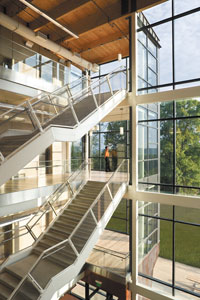Iowa to get an eco-edifice George Jetson can love

.bodytext {float: left; } .floatimg-left-hort { float:left; margin-top:10px; margin-right: 10px; width:300px; clear:left;} .floatimg-left-caption-hort { float:left; margin-bottom:10px; width:300px; margin-right:10px; clear:left;} .floatimg-left-vert { float:left; margin-top:10px; margin-right:15px; width:200px;} .floatimg-left-caption-vert { float:left; margin-right:10px; margin-bottom:10px; font-size: 10px; width:200px;} .floatimg-right-hort { float:right; margin-top:10px; margin-left:10px; margin-bottom:10px; width: 300px;} .floatimg-right-caption-hort { float:left; margin-right:10px; margin-bottom:10px; width: 300px; font-size: 10px; } .floatimg-right-vert { float:right; margin-top:10px; margin-left:10px; margin-bottom:10px; width: 200px;} .floatimg-right-caption-vert { float:left; margin-right:10px; margin-bottom:10px; width: 200px; font-size: 10px; } .floatimgright-sidebar { float:right; margin-top:10px; margin-left:10px; margin-bottom:10px; width: 200px; border-top-style: double; border-top-color: black; border-bottom-style: double; border-bottom-color: black;} .floatimgright-sidebar p { line-height: 115%; text-indent: 10px; } .floatimgright-sidebar h4 { font-variant:small-caps; } .pullquote { float:right; margin-top:10px; margin-left:10px; margin-bottom:10px; width: 150px; background: url(http://www.dmbusinessdaily.com/DAILY/editorial/extras/closequote.gif) no-repeat bottom right !important ; line-height: 150%; font-size: 125%; border-top: 1px solid; border-bottom: 1px solid;} .floatvidleft { float:left; margin-bottom:10px; width:325px; margin-right:10px; clear:left;} .floatvidright { float:right; margin-bottom:10px; width:325px; margin-right:10px; clear:left;} Rain lashed the Lewis and Clark State Office Building as BNIM architect Rod Kruse showed a tour group the vast view of the limestone river bluffs framed by huge, energy-efficient windows. BNIM designed the Jefferson City, Mo. building, which houses Missouri’s Department of Natural Resources, to be the acme of green technology.
But Kruse’s tourists were enchanted by a restful swooshing noise the rain made on the roof.
“They thought we’d installed something up there to create white noise to de-stress,” Kruse said. “All I could think of were dozens of toilets flushing.”
No wonder. The rainwater is piped into a basement storage tank and later used to flush toilets.
That’s just one eco-innovation Kruse will discuss with Iowa Board of Utilities officials who hired BNIM to design the agency’s new Des Moines headquarters.
BNIM won a Platinum Award, the U.S. Green Building Council’s highest honor, for the Lewis and Clark in 2005. BNIM wants to win another for the planned 37,000-square-foot Iowa Utilities Board building.
Although BNIM is based in Kansas City, Mo., it recently opened an office in Des Moines. Kruse will be pointman on the firm’s Iowa projects.
Iowa legislators set a more modest goal for the proposed 350,000-square-foot replacement for the Henry A. Wallace Building.
The Lawmakers mandated that the new office building “must have potential (to win) silver certification.”
A building earns basic certification, silver, gold or platinum based on the points it is awarded in categories such as water conservation, materials used in construction and indoor air and light quality.
The maximum points that can be earned are 100. Platinum requires more than 80 points.
Officials from Iowa’s Department of General Services, which oversees state construction projects, toured the Lewis and Clark building last year to examine its green elements. They were pleased with what they saw.
“We want our headquarters to be an energy-efficient showpiece that draws people from all over the country,” Utilities Board spokesman Chuck Seal said. “We hope it can be a role model for municipalities and school districts.”
The site for the agency’s new headquarters is located at the intersection of East 14th Street and Court Avenue. The 105 employees of the board and the consumer advocate’s office will occupy the $7.5 million building, which should be completed by 2009.
The new building will also be home to hearing rooms, which can hold 150 people.
BNIM associate director Brad Nies believes many Lewis and Clark innovations can be used in Iowa.
“When the Lewis and Clark workers wash their hands in a sink, water flows down to the tank where we collect rainwater,” Nies said. “The term for that water is gray water.
“We use it to flush the toilets and water lawns. But no one ever washes in it or drinks it.”
Men’s room urinals require no flushing. Instead, the urine flows into a drain pipe dropping through a chemical that prevents any smell from escaping into the restroom.
“Urine is heavier than the chemical, so it falls through without any water flushing it down,” Nies said.
“The chemical is odorless; I swear it does not smell like septic tank chemicals,” he explained. “Between the gray-water toilets and waterless urinals, the building saves 40,000 gallons of water annually.”
It took a few months to solve every glitch at the eco-edifice.
Dan Walker, the general services program director for Missouri’s DNR, said some of the Department’s 400 workers objected to the loss of privacy when their cubicle partitions were lowered.
The alteration was made so they could rely on sunshine rather than fluorescent light.
Lewis and Clark windows are fitted with light ledges; polyester flaps that reflect light inside or deflect it away, depending on the time of day. Walker calls it “harvesting daylight.”
Walker said the ledges had to be adjusted because workers complained of computer screen glare.
“But overall, they were happy,” Walker said. “Our job is to protect natural resources. We’re saving electricity and water.
“Every worker has a window view because of the way cubicles are positioned,” he added.
Workers loved the environmentally-friendly heating/cooling system because every cubicle is outfitted with an individual thermostat.
At Lewis and Clark, 68-degree air blows up from floor vents. Employees can adjust the vents to their comfort.
“A typical air conditioner blows cold air at you from vents above your head while hot, stale air is pulled out,” Nies said.
“Cool, clean air has to fight past hot, dirty air. With our method, cool air reaches the workers directly.”
The waterless urinals gave Lewis and Clark janitorial curves some initial, smell-oriented challenges. Walker said it took a few weeks to figure out how often the chemical sealant inside the pipe should be changed.
“When it smelled, we called the janitorial service; it was no big deal,” Walker said. “Now they change it at least every six weeks and there is no odor at all.”
It cost approximately $17 million to construct the 120,000-square-foot Lewis and Clark building.
Iowa’s new Utilities Board building will be less than a third that size yet it has almost half the much bigger building’s budget.
Waste News, a trade journal, estimates green buildings can add up to 6 percent to construction costs. Asked about extra costs, Seal replied, “We’ve got $7.5 million. Anything more requires major discussion.”
Kruse says building green on that budget is an obtainable goal. “Contractors might tell us it costs $41 more per square foot to build green, but green building saves that much more in water and electricity,” Kruse said.
“You can be economical and friendly to the environment.”








